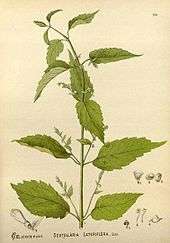Scutellaria lateriflora
| Scutellaria lateriflora | |
|---|---|
| | |
| Scientific classification | |
| Kingdom: | Plantae |
| (unranked): | Angiosperms |
| (unranked): | Eudicots |
| (unranked): | Asterids |
| Order: | Lamiales |
| Family: | Lamiaceae |
| Genus: | Scutellaria |
| Species: | S. lateriflora |
| Binomial name | |
| Scutellaria lateriflora L. | |
Scutellaria lateriflora, known commonly as blue skullcap, mad dog skullcap,[1][2] and side-flowering skullcap, is a hardy perennial herb of the mint family, Lamiaceae, native to North America.
It has an upright habit, growing 60 to 80 centimeters in maximum height.[3][4] It is a wetland-loving species and grows near marshes, meadows, and other wet habitat. The blue flowers are just under a centimeter long.[3][4] Most of the flowers do not appear at the top of the main stem, but are produced along the length of side branches that grow from the leaf axils.
Traditional uses
Scutellaria lateriflora is used in herbal medicine as a mild sedative and sleep promoter. Other skullcaps used for similar purposes include common skullcap (S. galericulata), western skullcap (S. canescens), and southern skullcap (S. cordifolia). In a small-scale double blind, placebo-controlled study, blue skullcap had anxiety-reducing effects in 19 volunteers.[5] S. lateriflora, along with reducing anxiety, significantly enhanced global mood without a reduction in energy or cognition.[6]
β-Elemene in the herb had potential anti-cancer properties in vitro,[7] but studies in humans have not confirmed its effectiveness.[8] Diterpenes isolated from S. barbata had cytotoxic activity against three human cancer cell lines in vitro.[9]
Pharmacology

The principal phenolics in the leaves, stems, and roots of some Scutellaria species are baicalin, baicalein, wogonin, and oroxylin A.[10][11] Baicalin has anti-inflammatory and analgesic effects in a rat model of thermal hyperalgesia.[12][13] Another study identifies 5,6,7-trihydroxy-2'- methoxyflavone and its 7-O-glucuronide.[14] A number of the flavones found in S. lateriflora have been reported to selectively bind with high affinity to central benzodiazepine receptor sites, leading to the view that the flavones exert anxiolytic and other benzodiazepine effects in rats.[15]
The flavonoids are found throughout the plant but are more concentrated in the leaves, and the concentrations are found to decrease slightly as the plant matures. The dried leaf is reported to contain about 50 milligrams of flavonoid per gram. The flavonoids are readily extracted using hot water.[13] A flavonoid-rich ethanolic extract of S. lateriflora protected hydrogen peroxide-UV induced cleavage of supercoiled plasmid DNA. Furthermore, these researchers found that the antioxidant effect of S. lateriflora based on the reduction of lipid peroxidation was comparable with that of the well-established and widely used antioxidant alpha-tocopherol.[16]
Scutellarin is transformed by hydrolysis into scutellarein.
Composition
| Chemical | Concentration (mg/g) |
|---|---|
| alpha-cubebene | 42 |
| alpha-humulene | 42 |
| beta-elemene | 92 |
| calamenene | 152 |
| delta-cadinene | 270 |
| Chemical | Concentration (mg/g) |
|---|---|
| carbohydrates | 780 |
| ascorbic acid | 1 |
| baicalin | 10[17] |
| scutellarin | |
| scutellarein | |
| tannin | 28-35 |
| wax | 12 |
See also
- Piper methysticum (kava), another anxiolytic GABAergic plant
- Valeriana officinalis (valerian), a sedative GABAergic plant
References
- ↑ Scutellaria lateriflora. NatureServe. 2012.
- ↑ mad dog, n. -compounds Oxford English Dictionary - mad dog because it was a supposed cure for hydrophobia
- 1 2 Jepson Manual Treatment
- 1 2 Washington Burke Museum
- ↑ Wolfson, P. and D. L. Hoffmann. (2002). An investigation into the efficacy of Scutellaria lateriflora in healthy volunteers. Alternative Therapies in Health and Medicine 9(2), 74-78.
- ↑ Brock C, Whitehouse J, Tewfik I, Towell T (2014). "American Skullcap (Scutellaria lateriflora): a randomised, double-blind placebo-controlled crossover study of its effects on mood in healthy volunteers.". Phytother Res: 692–8. doi:10.1002/ptr.5044. PMID 23878109.
- ↑ Li, Q. Q., et al. (2010). Antineoplastic effect of β-elemene on prostate cancer cells and other types of solid tumour cells. Journal of Pharmacy and Pharmacology 62(8), 1018-27.
- ↑ Peng, X., et al. (2006). Assessing the quality of RCTs on the effect of β-elemene, one ingredient of a Chinese herb, against malignant tumors. Contemporary Clinical Trials 27(1), 70-82.
- ↑ Qu, G. W., et al. (2010). Two new cytotoxic ent-clerodane diterpenoids from Scutellaria barbata. Journal of Asian Natural Products Research 12(10), 859-64.
- ↑ Nishikawa, K., et al. (1999). Phenolics in tissue cultures of Scutellaria. Natural Medicines 53(4), 209-13.
- ↑ Li J, Ding Y, Li XC, Ferreira D, Khan S, Smillie T, Khan IA (2009). "Scuteflorins A and B, dihydropyranocoumarins from Scutellaria lateriflora". J. Nat. Prod. 72 (6): 983–7. doi:10.1021/np900068t. PMID 19555121.
- ↑ "The Antiinflammatory and Analgesic Effects of Baicalin in Carrageenan-Evoked Thermal Hyperalgesia". Anesth Analg 97: 1724–1729. 2003. doi:10.1213/01.ane.0000087066.71572.3f.
- 1 2 Comparison of the Chemical Composition of Extracts from Scutellaria lateriflora Using Accelerated Solvent Extraction and Supercritical Fluid Extraction versus Standard Hot Water or 70% Ethanol Extraction. J. Agric. Food Chem., 53 (8), 3076 -3080, 2005
- ↑ Analysis of Scutellaria lateriflora and its adulterant Teucrium canadense by HPLC-UV and HPLC-UV/MS, Tom's of Maine, PO Box 710, Kennebunk, ME 04043. USA.
- ↑ Medina, J. H., et al. (1997). Overview – Flavonoids: A new family of benzodiazepine receptor ligands. Neurochemical Research 22(4), 419-25.
- ↑ Lohani et al. Nat Prod Commun. 2013 Oct;8(10):1415-18
- ↑ P.H. and Horhammer, L., Hager's Handbuch der Pharmazeutischen Praxis, Vols. 2-6, Springer-Verlag, Berlin, 1969-1979.
External links
- Connecticut Botanical Society: Scutellaria lateriflora
- Plants For A Future: Scutellaria lateriflora
- USDA Plants Profile: Scutellaria lateriflora
- Dr. Duke's Phytochemical and Ethnobotanical Databases
